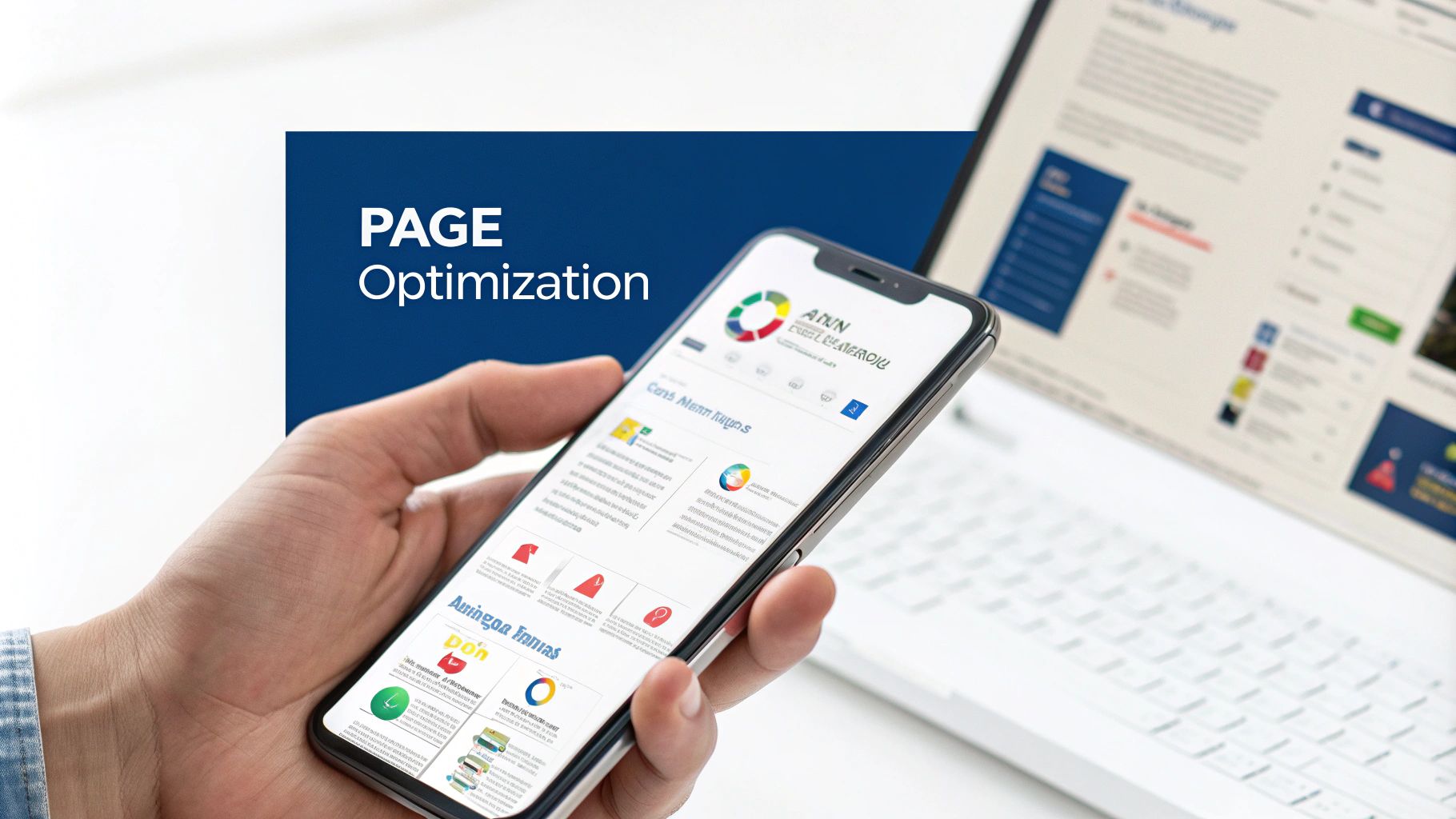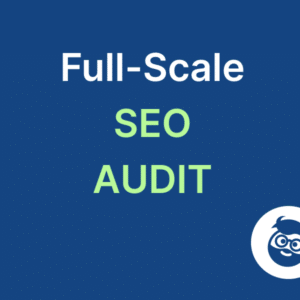Introduction to SEO Site Audits

Think of your website as a car. Just as regular maintenance, like oil changes and tire rotations, keeps a car running smoothly, an SEO site audit is a crucial "check-up" for your website's search engine performance. This audit involves a detailed analysis of various factors, including your website's technical infrastructure and content, which influence how easily search engines like Google can find and rank your site. As a result, SEO site audits help pinpoint areas for improvement, ultimately driving more organic traffic.
- Sale!

SEO Content Audit
Original price was: 1999,00 €.1799,00 €Current price is: 1799,00 €. Select options - Sale!

Search Rankings and Traffic Losses Audit
Original price was: 3500,00 €.2999,00 €Current price is: 2999,00 €. Select options - Sale!

Full-Scale Professional SEO Audit
Original price was: 5299,00 €.4999,00 €Current price is: 4999,00 €. Select options
Why are SEO Site Audits Important?
Much like a mechanic identifies potential car problems before they become major issues, an SEO site audit proactively uncovers hidden obstacles that might be hindering your website's performance. This means you can address these issues before they negatively impact your search rankings. For instance, a broken link might seem insignificant, but it can disrupt user experience and signal poor site maintenance to search engines. Furthermore, SEO site audits offer a valuable understanding of your website's current performance and pinpoint opportunities to boost its visibility.
What Does an SEO Site Audit Entail?
A thorough SEO site audit covers several key areas. The audit carefully examines technical aspects, such as site speed, mobile-friendliness, and how easily search engines can crawl your site. Content quality, keyword optimization, and internal linking structure are also evaluated. This comprehensive analysis provides a complete view of your website's strengths and weaknesses from an SEO perspective. This, in turn, leads to specific recommendations for enhancing each element to maximize your search engine rankings. These recommendations might range from optimizing title tags and meta descriptions to improving site architecture and fixing broken links. As an example, a site audit might reveal that your website lacks a sitemap, which is essential for search engines to understand your site's structure and effectively index its pages. To explore this further, learn more in our article about SEOBRO Agency news.
The Benefits of Regular SEO Site Audits
Regular SEO site audits are essential for maintaining and improving your website’s search engine rankings. Search engine algorithms and best practices are constantly changing. Therefore, regular SEO site audits, at least every six months, are crucial for staying ahead of these changes. Consistent audits ensure your website remains optimized and aligned with current search engine guidelines. They also help you adapt to algorithm updates or shifts in user behavior, protecting your website's visibility and encouraging sustainable organic growth.
Technical SEO Audit Elements

While the previous sections introduced the overall importance and scope of SEO site audits, this section focuses on the technical elements. These foundational aspects can significantly impact your website's search engine visibility. Think of technical SEO as the engine of your car: if it's not running smoothly, the rest of the vehicle won't perform optimally. Similarly, flaws in your website's technical SEO will prevent your content and other SEO efforts from reaching their full potential. Consequently, a technical SEO site audit is vital for uncovering these underlying issues.
Crawlability and Indexability
Ensuring search engines can access and understand your website's structure is the first step in getting noticed. This is where crawlability and indexability become important. Crawlability refers to how easily search engine bots can access and navigate your website's pages. Indexability, on the other hand, refers to whether these pages are added to the search engine's index, making them searchable. If your robots.txt file blocks important pages, for example, search engines won't be able to crawl or index them, effectively making them invisible in search results. Furthermore, complex JavaScript frameworks, if not implemented correctly, can sometimes hinder crawlability.
Site Speed and Performance
In today’s online world, users expect fast loading times. Site speed is crucial not only for user experience but also as a significant ranking factor for search engines. A slow website can result in higher bounce rates, frustrated users, and, ultimately, lower search rankings. During a technical SEO site audit, tools are used to analyze your website's loading speed and pinpoint areas for improvement. This might involve optimizing images, using browser caching, and minimizing HTTP requests. By improving site speed, you can greatly enhance both user experience and search engine visibility.
Mobile-Friendliness
With the rise of mobile device usage, ensuring your website is mobile-friendly is paramount. A responsive design that adapts to different screen sizes is essential. A technical SEO site audit checks your website's mobile compatibility, looking for any issues that might hinder the user experience on smartphones and tablets. This includes testing for touch screen navigation, font sizes, and overall layout. A poor mobile experience can negatively impact your search rankings, particularly since Google now prioritizes mobile-first indexing, meaning they primarily use the mobile version of your site for indexing and ranking.
HTTPS and Security
Website security is crucial for both user trust and SEO. A technical SEO site audit verifies that your website uses HTTPS, which encrypts data transmitted between the user's browser and your server. This protects sensitive information and builds user confidence. Moreover, HTTPS is a ranking signal, giving secure websites a slight advantage in search results. This shows search engines that you prioritize user security, which they consider when ranking websites. For further reading on a related topic, check out: How to master sitemaps. In addition, a technical SEO site audit checks for other security vulnerabilities to ensure your website is protected against potential threats. This contributes to a positive user experience and maintains a healthy online presence.
Content Audit Process
Following a technical SEO audit, a content audit is the next crucial step in a comprehensive SEO site evaluation. This process systematically analyzes all your website content to identify strengths, weaknesses, and opportunities for improvement. Just as an archaeologist carefully excavates a site to uncover its history, a content audit digs deep into your website’s content to understand its current state and potential. This detailed examination provides a roadmap for optimizing existing content and creating new, high-performing content.
Inventory and Analysis
The first stage of a content audit involves creating a complete inventory of all the content on your website. This means compiling a list of every page, blog post, and other content pieces. This inventory typically includes the URL, page title, meta description, word count, and other relevant details. For example, you might also track the date of the last update and the author of each piece. Once you have a complete inventory, you can begin the analysis. This involves evaluating each piece of content based on key metrics such as keyword relevance, search rankings, traffic generated, and overall quality.
Keyword Optimization and Relevance
A crucial part of content audits focuses on keyword optimization. This involves assessing how effectively your existing content targets relevant keywords. Are you using the right keywords to attract your intended audience? Are your keywords strategically placed within the content? This analysis uncovers opportunities to optimize existing content for better search visibility. You might find, for example, that some pages target keywords that are too competitive or irrelevant to your business. Additionally, you may discover content gaps—areas where you have no content covering important keywords in your niche.
Content Quality and User Experience
Beyond keyword optimization, SEO site audits prioritize content quality and user experience. Is your content engaging, informative, and easy to read? Does it provide value to your target audience? Does it align with your brand’s voice and style? These factors play a significant role in both user engagement and search engine rankings. A piece of content might be perfectly optimized for keywords, but if it's poorly written or irrelevant, it won't perform well. Therefore, factors like readability, clarity, and the overall user experience are critical. Remember, search engines prioritize content that provides genuine value to users.
Identifying Redundancies and Gaps
Another key aspect of the content audit within SEO site audits is identifying redundancies and gaps in your content. Do you have multiple pages covering the same topic? Are there important topics you haven't addressed at all? Identifying redundant content allows you to consolidate it, improving site architecture and avoiding keyword cannibalization (where multiple pages on your site compete for the same keyword). Conversely, finding content gaps presents opportunities to create new content that expands your website's topical coverage. This not only improves your chances of ranking for more keywords but also builds a more comprehensive resource for your audience.
On-Page SEO Analysis

Building upon the foundation of technical and content audits, on-page SEO analysis is the next critical component of effective SEO site audits. This stage focuses on optimizing individual web pages to improve their search visibility and user experience. Imagine building a house: after the foundation and structure are complete, you decorate and furnish it. While a solid structure is essential, the interior design makes it appealing and functional. Similarly, on-page SEO enhances your website's appeal and functionality for both users and search engines. It involves refining elements within each page to better align with target keywords and user intent.
Showing 1–3 of 5 resultsSorted by popularity
- Sale!

White Label SEO Audit
Original price was: 5299,00 €.4999,00 €Current price is: 4999,00 €. Select options - Sale!

SEO Content Audit
Original price was: 1999,00 €.1799,00 €Current price is: 1799,00 €. Select options - Sale!

Search Rankings and Traffic Losses Audit
Original price was: 3500,00 €.2999,00 €Current price is: 2999,00 €. Select options
Keyword Optimization within Content
A cornerstone of on-page SEO analysis during SEO site audits is optimizing keyword usage within the content itself. This goes beyond simply including keywords; it involves strategically integrating them into the narrative naturally and meaningfully. For example, if you're optimizing a page about "organic coffee beans," avoid awkwardly stuffing the keyword into every sentence. Instead, focus on creating informative and engaging content that naturally incorporates related terms like "fair trade," "single origin," "roasting profiles," and "brewing methods." This approach not only satisfies search engine algorithms but also provides valuable information to users interested in organic coffee.
Optimizing Title Tags and Meta Descriptions
Crafting compelling title tags and meta descriptions is another essential aspect of on-page optimization. These elements are your website’s storefront in search engine results pages (SERPs), enticing users to click through to your site. The title tag, similar to a headline, should accurately reflect the page's content and include the primary keyword. For a page about SEO site audits, a title tag like "SEO Site Audits: A Comprehensive Guide to Improve Your Rankings" is clear, concise, and keyword-rich. The meta description acts as a brief preview, further elaborating on the page’s content and encouraging clicks. A well-written meta description can significantly improve your click-through rate (CTR), a positive signal to search engines.
Enhancing User Experience through Readability
While keyword optimization is crucial, on-page SEO analysis also emphasizes user experience, which includes factors like readability, site navigation, and overall design. Think of your website as a bookstore: if the books are disorganized and difficult to find, customers will leave frustrated. Similarly, if your website is cluttered, hard to navigate, or full of jargon, users will quickly bounce, negatively impacting your search rankings. During an SEO site audit, assess your website's readability by ensuring clear and concise language, a logical content structure, and visually appealing design. This includes using headings, subheadings, bullet points, and images to break up text and make it easier to digest.
Optimizing Images and Other Media
SEO site audits often reveal opportunities to optimize images and other media for better search visibility and user experience. Just as a well-placed photograph can enhance a story, optimized images improve your website's engagement and SEO. This involves using descriptive alt text for images, compressing image files for faster loading, and ensuring image relevance to the surrounding content. For example, if you have a picture of a coffee cup on your “organic coffee beans” page, the alt text could be "Steaming cup of freshly brewed organic coffee." This gives context to search engines and improves accessibility for users using screen readers. This detailed approach ensures your visuals positively contribute to both user experience and search engine rankings. By addressing these on-page elements, you can significantly enhance your website's performance and achieve better results from your SEO efforts.
Tools and Resources

After thoroughly analyzing your website through technical, content, and on-page SEO audits, the right tools can streamline the process and provide deeper insights. These tools act like a magnifying glass, allowing for a more precise examination of your website’s SEO health. Choosing the right tool for your SEO site audits is crucial for efficient analysis and effective optimization. This means considering the depth of analysis needed, your budget, and the specific features offered by each tool.
Free SEO Audit Tools
Several free SEO audit tools provide a good starting point for website analysis. These tools often give a basic overview of your website's SEO performance, highlighting key areas for improvement. This can be especially helpful for small businesses or website owners with limited budgets. Google Search Console and Google Analytics, for example, are invaluable free resources. Google Search Console provides essential data on your website’s crawlability, indexability, and search performance. Google Analytics, on the other hand, offers insights into user behavior and traffic sources. While basic, these tools offer valuable information to guide your SEO strategy.
Paid SEO Audit Tools
While free tools provide a good foundation, paid SEO audit tools offer more comprehensive analysis and advanced features. These tools often include features like backlink analysis, competitor analysis, and keyword research tools. This deeper analysis can be essential for identifying more complex SEO issues and creating more effective optimization strategies. Tools like Ahrefs, SEMrush, and Moz, for instance, offer a wide range of features for in-depth SEO site audits. These platforms allow you to analyze your website's backlink profile, track keyword rankings, and research your competitors. For serious SEO professionals, investing in these tools can be transformative.
Choosing the Right Tool for Your Needs
The best SEO audit tool depends on your specific circumstances. If you’re a small business owner with limited resources, starting with free tools like Google Search Console and Google Analytics is a sensible approach. However, as your business grows and your SEO needs become more complex, investing in a paid tool becomes increasingly beneficial. When making your decision, consider the features offered, the cost, and the level of support provided. The right tool should align with your specific goals and provide the data necessary to achieve them. This ensures you're equipped to conduct thorough SEO site audits and implement effective optimization strategies. For further insights on maximizing your website's structure, see: How to master sitemaps. Ultimately, the right tool empowers you to make informed decisions based on data and maximize your website's search visibility.
Conclusion
SEO site audits aren't a one-time activity; they are an ongoing process, much like regular car maintenance. This post explored the importance of SEO site audits, examining the technical details, the thorough content audit process, the nuances of on-page optimization, and the various tools available to streamline this essential task. By implementing the strategies and techniques discussed, you can significantly enhance your website's visibility in search results, attract more organic traffic, and ultimately drive business growth.
Key Takeaways From This Guide on SEO Site Audits
- Technical SEO: A technically sound website forms the foundation of effective SEO. Addressing issues like crawlability, site speed, and mobile-friendliness is essential for search engines to access and index your site properly. Think of it as ensuring your car's engine is running smoothly.
- Content Audits: Analyzing existing content helps identify areas for improvement, pinpoint content gaps, and ensure your content resonates with your target audience. This is like organizing your car’s interior—making sure everything is in its place and easy to find.
- On-Page Optimization: Optimizing individual pages by refining title tags, meta descriptions, and keyword usage enhances user experience and improves search visibility. This is comparable to adding those final touches to your car, such as a new coat of paint or seat covers, to make it more appealing.
- Utilizing Tools: Leveraging SEO tools, both free and paid, equips you with the data and insights necessary for conducting effective SEO site audits and tracking your progress. This is like using diagnostic tools to identify potential car problems before they become major issues.
Next Steps to Take After an SEO Site Audit
Conducting an SEO site audit is the first step. The true benefit comes from implementing the audit’s recommendations. This might involve fixing technical problems, optimizing existing content, creating new content to address gaps, or refining your on-page SEO. Prioritizing these actions sets the stage for improved search rankings and increased organic traffic. Just as regular car maintenance ensures a smooth ride, consistent SEO site audits are key to maintaining a healthy and high-performing website.
- Sale!

SEO Content Audit
Original price was: 1999,00 €.1799,00 €Current price is: 1799,00 €. Select options - Sale!

Search Rankings and Traffic Losses Audit
Original price was: 3500,00 €.2999,00 €Current price is: 2999,00 €. Select options - Sale!

Full-Scale Professional SEO Audit
Original price was: 5299,00 €.4999,00 €Current price is: 4999,00 €. Select options
Ready to boost your website's SEO performance? SEOBRO Agency specializes in data-driven SEO strategies tailored to your specific needs. From comprehensive SEO site audits to technical optimization and content strategy, we provide the expertise you need to achieve sustainable organic growth. Visit https://seobro.agency today to learn more and transform your website into a powerful lead-generating engine.







